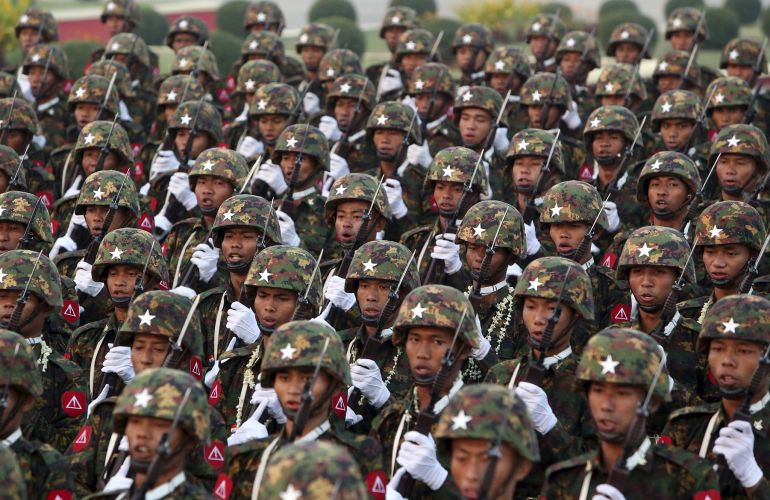
Aung Kaung Myat considers the moral and analytical layers in addressing the military institution as “Tatmadaw” or “sit-tat.”
The anti-coup movement prompts a critical reflection on how to best describe the most powerful institution in the country, which is long missing from studies and analyses of Burma. This article engages with the debate and examines other ways to refer to the Burmese military.
“Tatmadaw” (တပ်မတော်) has long been adopted as the standard title of the Burmese military in journalistic and scholarly reports on Burma. The critics called on writers to replace the term with “sit-tat” (စစ်တပ်), which simply means “military” in Burmese. The official Twitter account of the Civil Disobedience Movement asked to avoid using the term “tatmadaw,” as seen in a viral tweet posted on October 2021. A commentary written by a Burmese aid worker also objects to the use of the term. Their justifications are grounded in moral reasoning. Because of the laudatory nature of the royal particle daw (တော်) included in the term, critics say the continuous use of the term amounts to whitewashing over the crimes committed by the institution and even risks emboldening them to continue their abuses.
Of course, there is nothing royal about the institution and its soldiers who overthrew popularly elected officials, opened fire on unarmed protestors, torched villages in the drylands, and committed mass atrocities against minorities. However, the primary objective of many works using the term is to report, criticize or analyze the patterns of abuses or authoritarian policies under the regime rather than to glorify them. There is, indeed, little evidence that those who use “tatmadaw” sympathize with the institution behind the term. Regardless, the implied moral judgment associated with the term can hardly be ignored because good writers should always pay attention to the weight their words carry.
In addition to the moral issue, there is an analytical gap between native and non-native speakers of Burmese language. Most English-language writings on Burma assume “tatmadaw” as a proper noun, as is evident from the persistent use of the term in a capitalized form. On the contrary, many native Burmese speakers from the military generals to pro-democracy groups and the general public use the term as a common noun. In a Burmese translation of the Commander-in-chief Min Aung Hlaing’s interview with Asahi Shimbun, he pointed out that “the American tatmadaw” also committed war crimes in Vietnam and Afghanistan to justify his army’s brutal campaign on the Rohingya. The official name for the People’s Defence Force (PDF) fighting the junta is called pyi-thu ka-kwe-ye tatmadaw or People’s Defence Tatmadaw according to the NUG’s website. The biggest ethnic armies such as the Karen National Liberation Army, the Kachin Independence Army, the Ta’ang National Liberation Army, the Shan State Army and the United Wa State Army are also called “tatmadaws” representing their own ethnic groups in everyday speech and media reports. The examples shows that the term “tatmadaw” is hardly unique and singular.
Awareness of these issues leads some writers to use “sit-tat”. Devoid of any positive or glorified image, this term could perhaps satisfy critics of the Burmese military. But it doesn’t solve the analytical issue because “sit-tat” remains to be a common noun. When we say “army” in English, we don’t mean the British Armed Forces. By the same logic, the Burmese word for army, “sit-tat,” should not be the designated label for it in English.
What should the institution be called then? Unfortunately, there are few alternatives. The Burmese military held many labels in its formative years such as the Burma Independence Army, the Burma Defence Army, the Burma National Army and the Patriotic Burma Army. But none of these terms survived to this day. The non-Bamar groups called it “Bamar sit-tat” or “Bamar army” in the past. But this is inappropriate and even slanderous at a time thousands of ethnic Bamars in the drylands face torchings and killing campaigns of the army and the Bamars in urban areas are subject to torture and mistreatment. Some pro-democracy groups call it Min Aung Hlaing’s “sit-tat” or military, but it is wrong to assume Min Aung Hlaing is the source rather than a symptom of the problem.
At present, there is no single best way to call it. But terms such as Burmese/Myanmar Military or Armed Forces of Burma/Myanmar are better than other alternatives. Admittedly, they are not satisfactory for a writer looking for a second reference to the Burmese military. But they arguably solve the moral and analytical issues discussed above as long as the institution in question satisfies two conditions: it continues to be a military and it controls the country, albeit against popular will. Perhaps things might change in the future if the national army is replaced by one which accepts civilian oversight, receives popular support, complies with federal demands, and represents the interests of ordinary citizens. As one Twitter user says, “The name tatmadaw will be used after we win.”
Featured image by Gayatri Malhotra, from Unsplash.
Aung Kaung Myat is an MPhil candidate at the Department of Politics and Public Administration, University of Hong Kong. His research interests include ethnicity, nationalism, and armed conflict.
Like This Article
April 09, 2024
March 20, 2024

Center for Southeast Asian Studies, Asian Institute 1 Devonshire Place Toronto, Ontario, M5S 3K7, Canada
©TeaCircle All Rights Reserved 2023